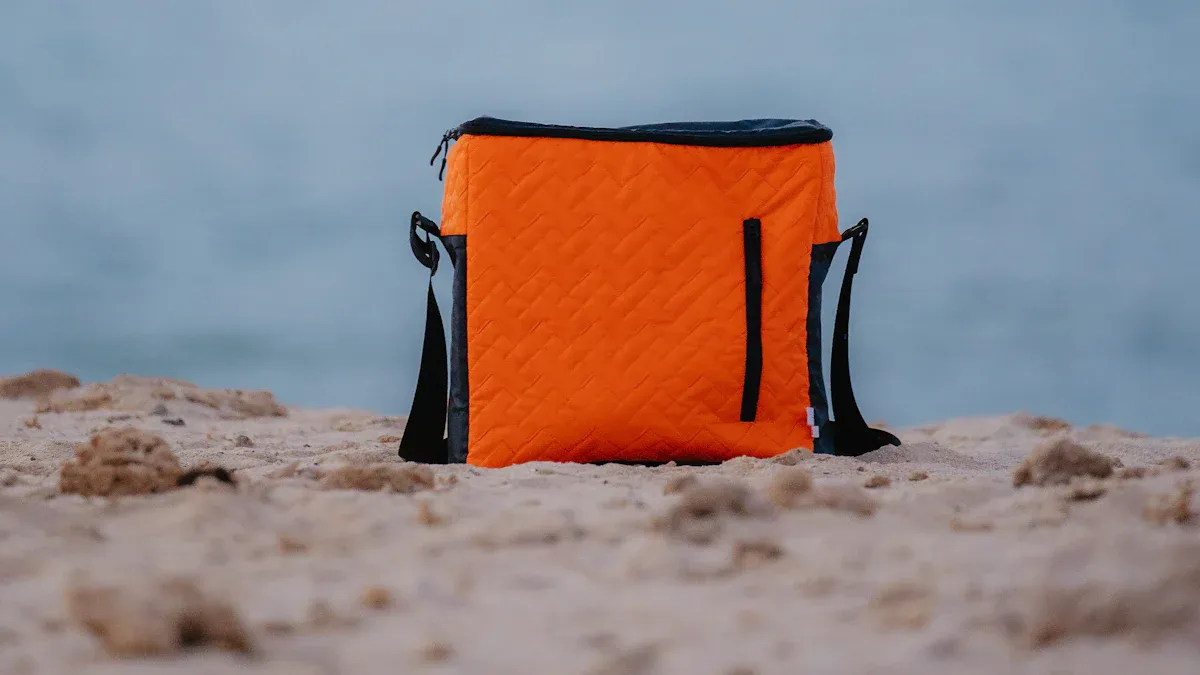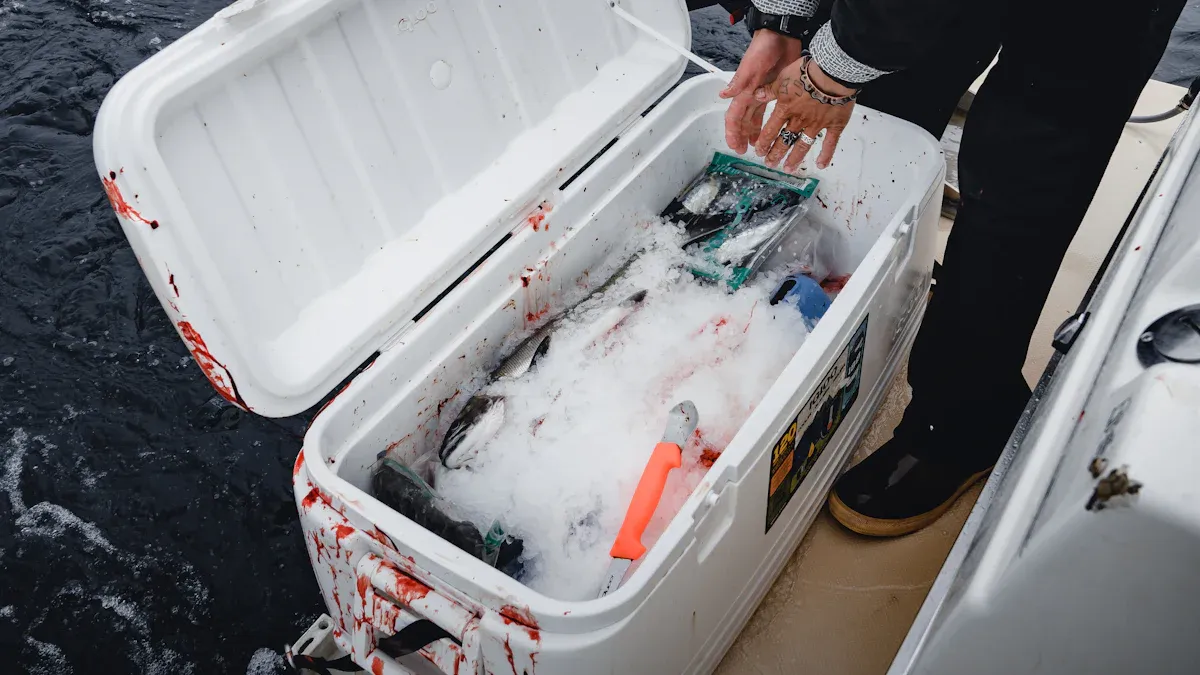
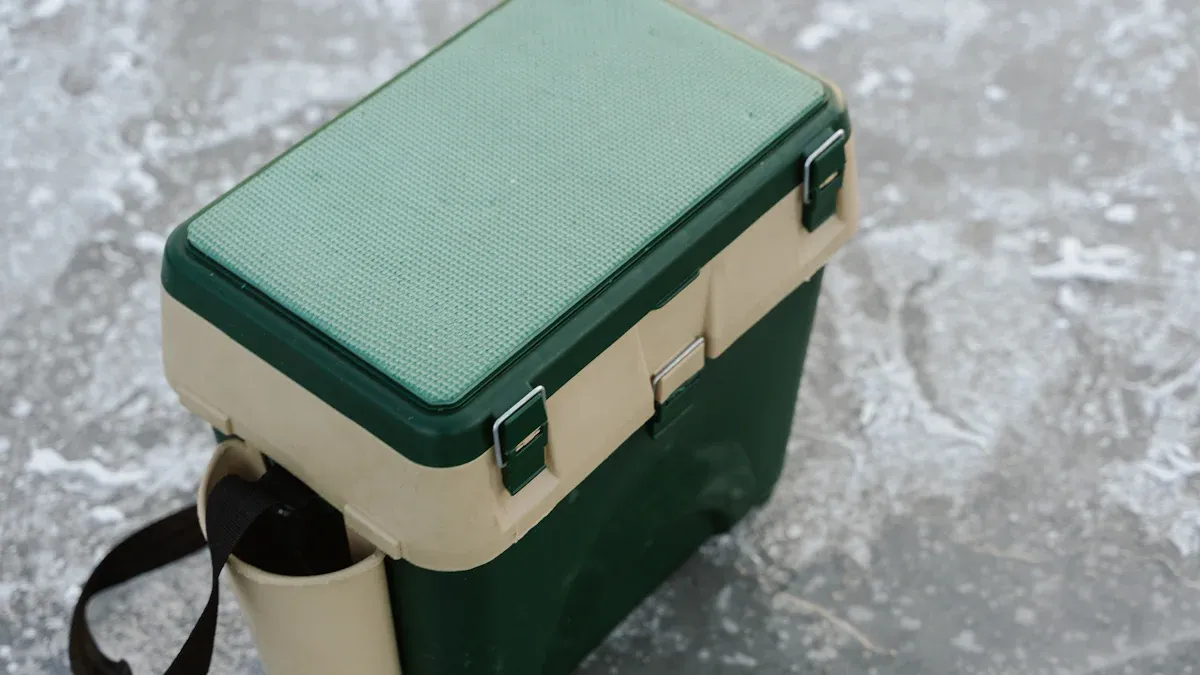
When you shop for an ice cooler box small, you want something that keeps your food fresh and fits your plans. Most buyers look for key features like:
- Strong build for rough use, even if you sit or step on it
- Great insulation that keeps ice for days
- Easy handles and lightweight for carrying
- Simple to open and close
- Small cooler size that matches your storage needs
- Handy extras like drain plugs or lockable lids
Your choice should fit your daily life, whether you go camping, head to the park, or just need a reliable cooler for travel. Picking the right ice cooler box small makes every adventure easier and a lot more fun.
Key Features of an Ice Cooler Box Small
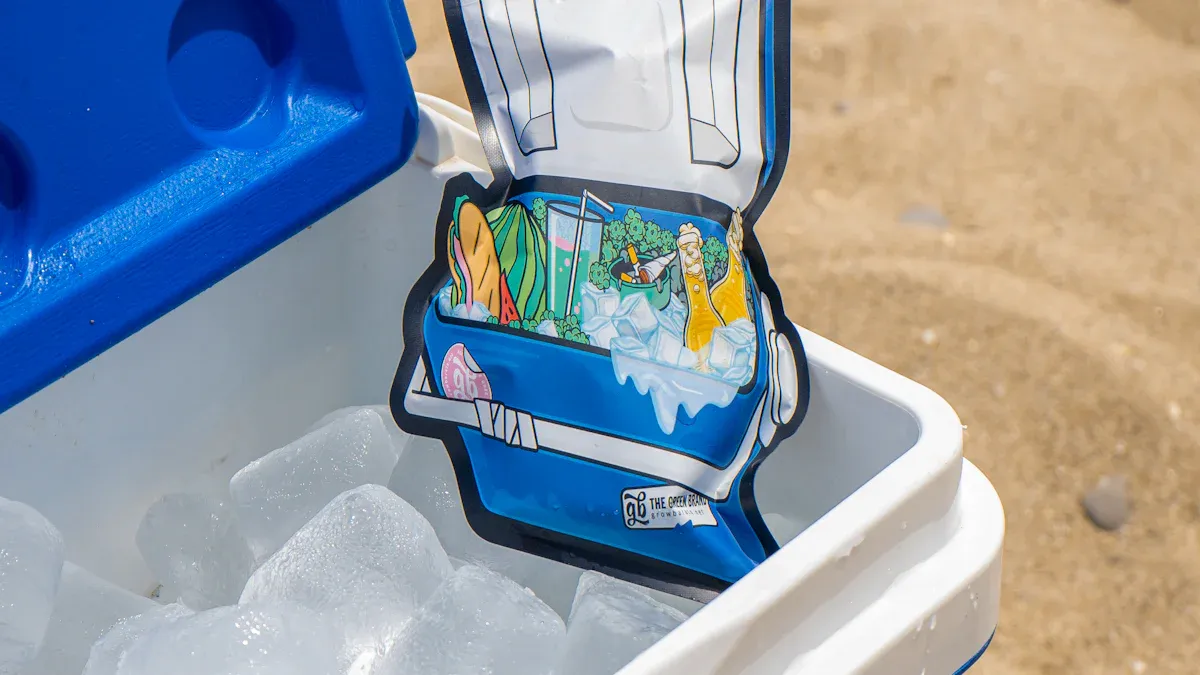
When you pick out a small cooler, you want it to do more than just keep things cold. The best small coolers combine smart design, strong materials, and handy extras. Let’s break down what really matters so you can find the perfect ice cooler box small for your next adventure.
Insulation Quality
Insulation is the heart of any small ice cooler. If you want your drinks icy and your food safe, you need a cooler that holds the cold for hours—or even days. The type and thickness of insulation make a huge difference. Here’s a quick look at how different materials stack up:
| Material Type | Thermal Conductivity (W/m·K) | Effective Duration | Notes |
|---|---|---|---|
| Vacuum Insulated Panels (VIP) | 0.003 to 0.008 | 96 hours and over | Up to 5x more efficient than traditional materials; best when combined with polyurethane |
| Polyurethane | 0.020 to 0.025 | 48 to 96 hours | Good efficiency; thinner walls than polystyrene |
| Extruded Polystyrene | 0.025 to 0.030 | Up to 48 hours | Traditional material; less efficient |
| Expanded Polystyrene | 0.030 to 0.035 | Up to 48 hours | Least expensive; bulkier |
You can see that vacuum insulated panels and polyurethane foam give you the best results for keeping things cold the longest. Some top-rated small coolers, like Engel’s rotomolded models, can keep ice for up to 10 days if you pack them right and keep them out of the sun. For most day trips, a small ice cooler with thick polyurethane insulation will do the trick.
Tip: Always fill your small cooler as much as possible and use plenty of ice packs. This helps keep everything at a safe temperature for longer.
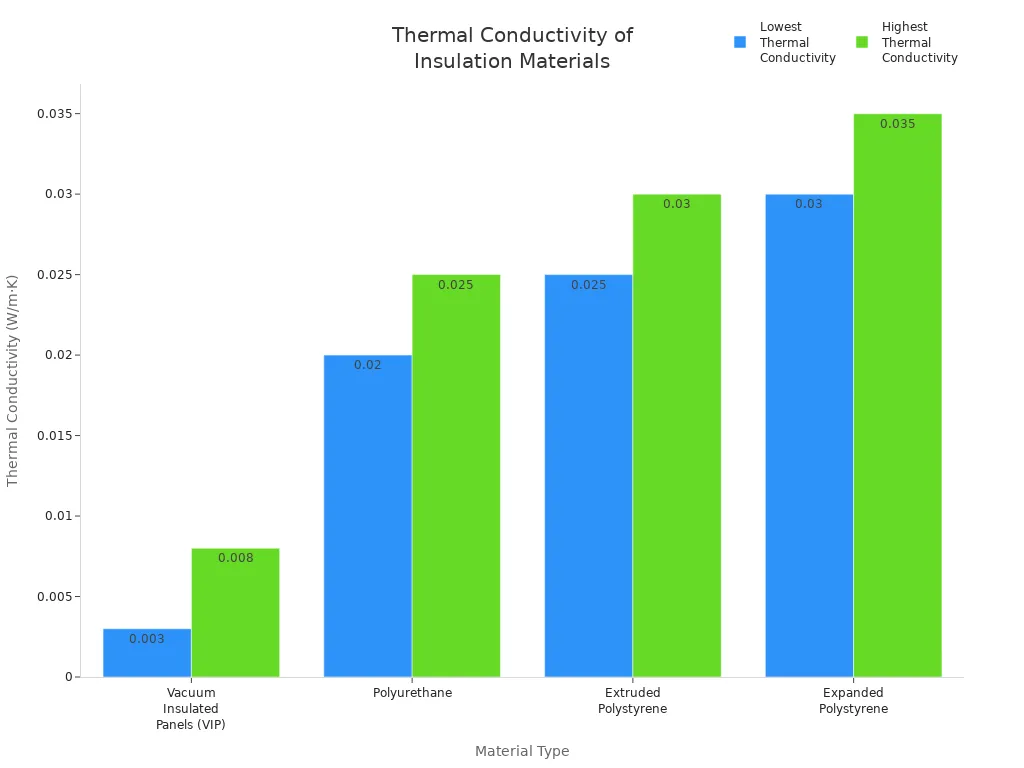
Portability
You want a small ice chest cooler that’s easy to carry, whether you’re heading to a picnic or a fishing spot. The best small coolers have comfortable handles, padded straps, or even backpack-style designs. Here are some features that make carrying a breeze:
- Padded shoulder straps (like those on backpack coolers) keep your shoulders happy, even when the cooler is full.
- Ergonomic handles help you grip and lift without straining your hands.
- Lightweight construction means you won’t struggle, even if you pack your small cooler with drinks and snacks.
Backpack coolers with padded straps, such as the Engel BP25 or Orca Wanderer 24, get high marks for comfort. If you plan to walk a lot, look for these features.
Durability
A small cooler should handle bumps, drops, and even double as a seat. Durability comes from both the materials and the way the cooler is made. KUER uses advanced manufacturing like rotomolding, injection molding, and blow molding to create tough, seamless cooler bodies. Here’s what sets durable small coolers apart:
- Thick, rotomolded plastic walls filled with high-quality polyurethane foam resist cracks and dents.
- Heavy-duty hinges, strong handles, and tight seals keep everything working smoothly.
- UV resistance and impact testing ensure your cooler stands up to sun and rough use.
- Patented designs and strict quality control mean you get a cooler that lasts.
Many users say they can sit or stand on their KUER small coolers without any damage. That’s real-world toughness you can count on.
Ease of Use
You want your small ice cooler to be simple and stress-free. First-time buyers often love these features:
- Easy-to-carry size—around 22 quarts fits most daily needs.
- Lightweight, even when full, so you don’t struggle to move it.
- Handles, straps, or wheels for smooth transport.
- Simple latches and lids that open and close without a fight.
- Quick-clean surfaces—just wipe with soap and water.
- Versatility—some small coolers double as a seat or table.
- Storage-friendly shape that fits in your car or closet.
Note: Choosing a small cooler that matches your routine saves you time and hassle. Think about where you’ll store it and how you’ll use it most.
Extra Features
The right extras can turn a good small ice cooler into a great one. Consumers love features that add convenience and fun:
- Built-in bottle openers for easy drink access
- Cup holders for outdoor events
- Integrated fish rulers for fishing trips
- Non-slip rubber feet for stability
- Quick-drain plugs for easy cleanup
- Lockable lids for security
- Freezer-style gaskets for a tight seal
Some modern small coolers even offer USB charging ports, LED lights, or bear-proof locks. These features boost usability and make your cooler more versatile, though they can raise the price. Most buyers agree that handy extras like drain plugs and sturdy latches are worth it for the added convenience.
| Cooler Type | Key Features & Usability Impact | Price Impact |
|---|---|---|
| Hard-side Coolers | Tight seals, strong build, good for food and drinks, may cost more for better insulation | Higher price for premium features |
| Soft Collapsible | Easy to store, lighter, but may leak if not sealed well | Lower price, but less durable |
| Backpack Coolers | Comfortable straps, extra pockets, good for hiking or beach | Moderate to higher price |
Extra features make your small ice cooler more fun and practical, especially for camping, fishing, or parties.
Choosing the Right Size Cooler
Picking the right small cooler can make your trip much easier. When you start choosing the right size cooler, think about how long you will be out, how many people you need to pack for, and where you will store your cooler. Let’s break down each part so you can find the right cooler for your needs.
Capacity Needs
You want a cooler that fits your food and drinks without wasting space. The right small cooler depends on your trip length and what you plan to pack. Here’s a quick guide to cooler sizes and what they can hold:
| Cooler Size (Quarts) | Trip Length / Group Size | Can Capacity Example |
|---|---|---|
| Up to 20 | Day trips, solo outings | ~16 cans |
| 20-30 | Day trips, small groups | ~32 cans (25 quart model) |
| 40-50 | Weekend camping, small groups | N/A |
| 50-75 | Extended camping, larger groups | N/A |
If you want the best size cooler for a party, look for something in the 40-50 quart range. For solo adventures or short trips, a 20-30 quart cooler is usually enough. Choosing the right size cooler helps you avoid carrying extra weight or running out of space.
Group Size
The number of people in your group changes your cooler size needs. If you travel alone, a small cooler works great. For two to four people, you might want a medium cooler for a day or two. Larger groups need bigger coolers or even more than one. Here’s a simple table to help with cooler selection:
| Group Size | Cooler Size Recommendation |
|---|---|
| Solo or 1 person | Small coolers for day trips |
| 2 to 4 people | Medium coolers for 1-2 day trips |
| 4 to 6 people | Large coolers for 2-3 day trips |
| More than 6 people | Very large coolers or multiple coolers |
If you have a big group, try using one cooler for drinks and another for food. This keeps things organized and helps your ice last longer.
Storage Space
When choosing the right size cooler, think about where you will keep it. Will it fit in your car, trunk, or closet? Here are some tips to save space and keep your cooler organized:
- Place ice under racks and food on top to use space well.
- Keep the drain closed unless you need to empty water.
- Use separate coolers for drinks and food to keep things cold longer.
- Pack food in watertight containers to avoid leaks and save space.
- Remove extra packaging before you pack your cooler.
- Freeze food and ice blocks at home to keep things cold and fill space.
Tip: Pre-cool your cooler before packing. This helps your ice last longer and keeps your food safe.
Choosing the right size cooler means thinking about your trip, your group, and your storage. With the right small cooler, you can enjoy your adventure without worry.
Types of Small Cooler
When you start shopping for small coolers, you’ll notice two main types: hard-sided and soft-sided. Each type has its own strengths, so let’s break them down to help you pick the best one for your needs.
Hard-Sided
Hard-sided small coolers have a tough, rigid shell. You’ll often see them made from rotomolded plastic. These coolers have thick walls and tight seals. This design keeps ice frozen for days, sometimes even up to a week or more. If you plan a camping trip or need to keep food cold for a long time, hard-sided small coolers work best. They can handle rough use, bumps, and even double as a seat. Many people love them for their durability and long-lasting ice retention.
Hard-sided small coolers are perfect for multi-day adventures or when you need to keep things cold in hot weather.
Soft-Sided
Soft-sided small coolers look more like bags or backpacks. They use flexible materials and closed-cell foam for insulation. These coolers are much lighter than hard-sided ones. You can fold or collapse them when not in use, which saves space. Soft-sided small coolers are easy to carry, especially if you’re hiking, biking, or just heading to the park for a few hours. However, they don’t keep ice as long—usually just a day or two.
Here’s a quick comparison to help you see the differences:
| Feature | Hard-Sided Coolers | Soft-Sided Coolers |
|---|---|---|
| Weight | Heavy, sturdy construction | Lightweight, flexible |
| Portability | Less portable, best for car trips | Easy to carry, foldable, padded straps |
| Ice Retention | Several days to a week | Several hours to a day or two |
| Durability | Very durable, impact-resistant | Less durable, can wear out |
Pros and Cons
Let’s look at what users like and dislike about each type of small cooler:
-
Hard-Sided Small Coolers
- 👍 Keep ice solid for days—great for long trips.
- 👍 Tough and can handle rough terrain.
- 👍 Hold more food and drinks.
- 👎 Heavy and bulky, harder to carry.
- 👎 Take up more storage space.
- 👎 Usually cost more.
-
Soft-Sided Small Coolers
- 👍 Super light and easy to carry.
- 👍 Fold up small for storage.
- 👍 Usually cost less.
- 👎 Don’t keep ice as long—best for short trips.
- 👎 Not as tough, can wear out faster.
- 👎 Hold less food and drinks.
Many campers say hard-sided small coolers are worth it for week-long trips. People who want something easy to carry for a picnic or beach day often pick soft-sided small coolers.
No matter which type you choose, think about how you’ll use your small cooler most. That way, you’ll get the best fit for your adventures.
Matching to Activities
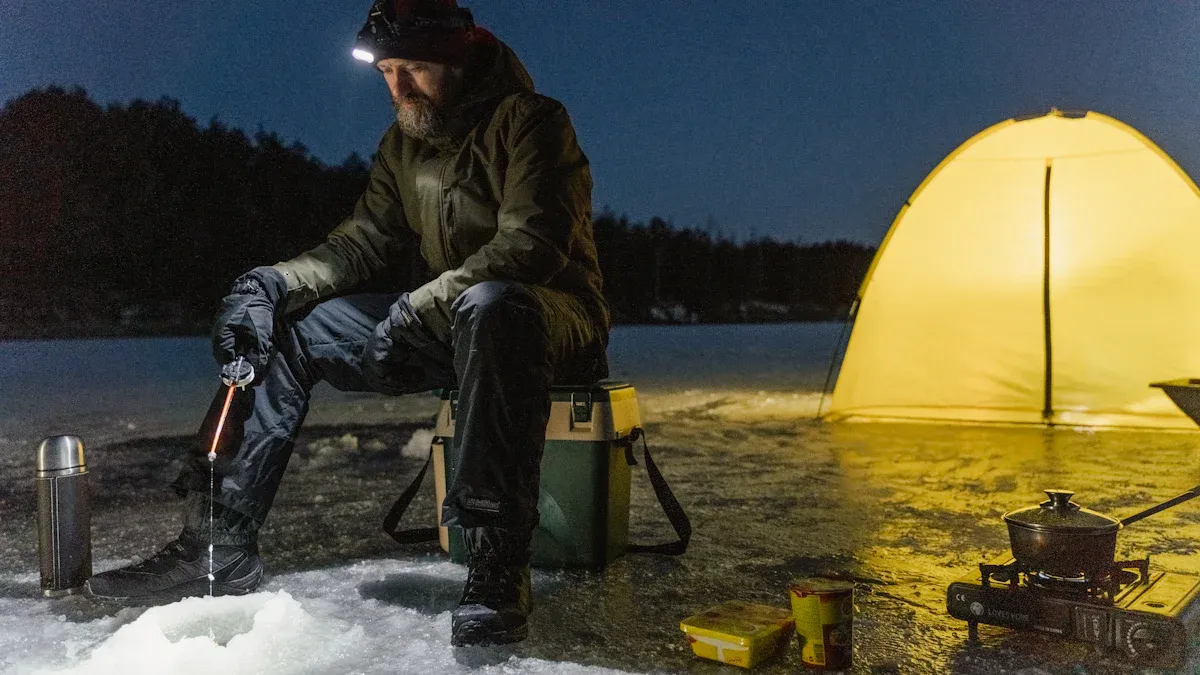
Day Trips
You want a cooler that keeps your snacks and drinks cold for a whole day. For picnics or short hikes, look for small coolers with strong ice retention, leakproof design, and easy carrying. Some models even have backpack straps or padded handles, so you can walk comfortably. Check out this table to compare popular options for day trips:
| Cooler Model | Ice Retention (hours) | Waterproof | Leakproof | Carry Comfort | Latch Quality | Notable Features |
|---|---|---|---|---|---|---|
| Hydro Flask Day Escape | 37 | Yes | Great | Great | Good | Backpack style, padded, even weight, tricky zipper |
| Orca Wanderer Tote | 60 | Yes | Great | Fair | Excellent | Simple latch, waterproof, great for picnics |
| Igloo Legacy 20 QT Cooler | 66 | Yes | Great | Great | Excellent | Twist latch, comfy handle, long ice retention |
| Titan 25Q Hard Cooler | 59 | Yes | Great | Good | Great | Interior light, easy latches |
| Titan Zipperless Cooler | 49 | No | Poor | Good | Good | Velcro latch, tray for perishables |
| Engel HD20 | 45 | Yes | Great | Fair | Fair | Vacuum insulation, waterproof, fiddly zipper |
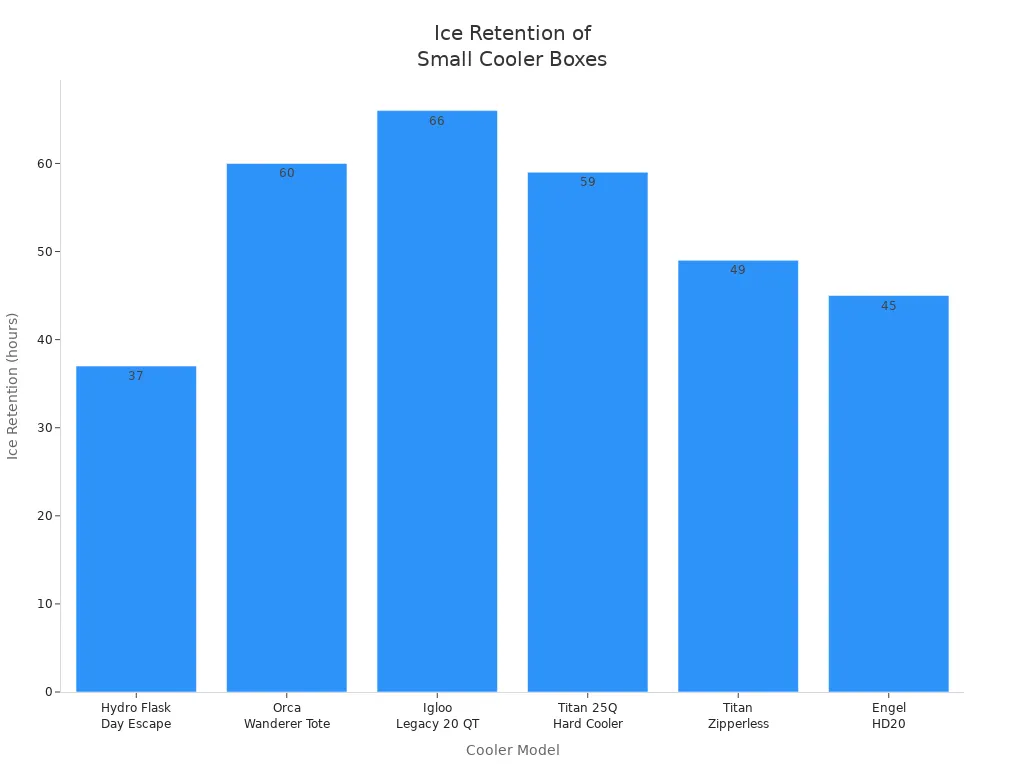
Tip: For a quick picnic, choose a cooler with at least 37 hours of ice retention and a comfortable handle or strap.
Outdoor Events
Heading to a concert or sports game? You need a cooler that is easy to carry, fits under your seat, and keeps drinks cold for hours. The Yeti Rambler Beverage Bucket stands out for these events. It holds up to 2 gallons, uses double-walled insulation, and has a padded handle for comfort. You can pick from several colors, and the sturdy lid keeps everything secure. Some users say it feels heavy when full, but the insulation makes up for it.
| Cooler Option | Dimensions (inches) | Capacity | Insulation Type | Portability Features | Pros | Cons |
|---|---|---|---|---|---|---|
| Yeti Rambler Beverage Bucket | 11.5 x 8.8 | 256 oz (2 gal) | Double-walled | Padded handle, secure lid | Keeps ice/drinks cold, sturdy, stylish | Lid doesn’t fit tall bottles, heavy |
For outdoor events, small coolers with strong insulation and easy-carry handles make your day much smoother.
Travel
Traveling by car or plane? You want a cooler that fits in tight spaces and keeps food safe. Soft-sided personal coolers work well for short trips, while hard-sided models protect your items on longer journeys. Here’s how some top models perform:
| Cooler Model | Type | 24h Insulation | Portability & Comfort | Best Use |
|---|---|---|---|---|
| Bellroy Lite Cooler Caddy 6L | Soft | Few hours | Fits in backpacks, compressible | Short trips, not for all-day cooling |
| YETI Hopper Flip 8 Soft Cooler | Soft | ~35.2°F | Padded strap, backpack carry | Longer travel, good retention |
| RTIC Soft Pack Cooler (20 Can) | Soft | ~32.8°F | Handles, floats, durable | Extended trips, budget-friendly |
| Stanley Adventure Easy Carry | Hard | ~33.2°F | Hard shell, heavier | Best for trunk storage |
| Mountainsmith Sixer Cooler Bag | Soft | ~62.4°F | Lightweight, removable straps | Beach or park, short trips |
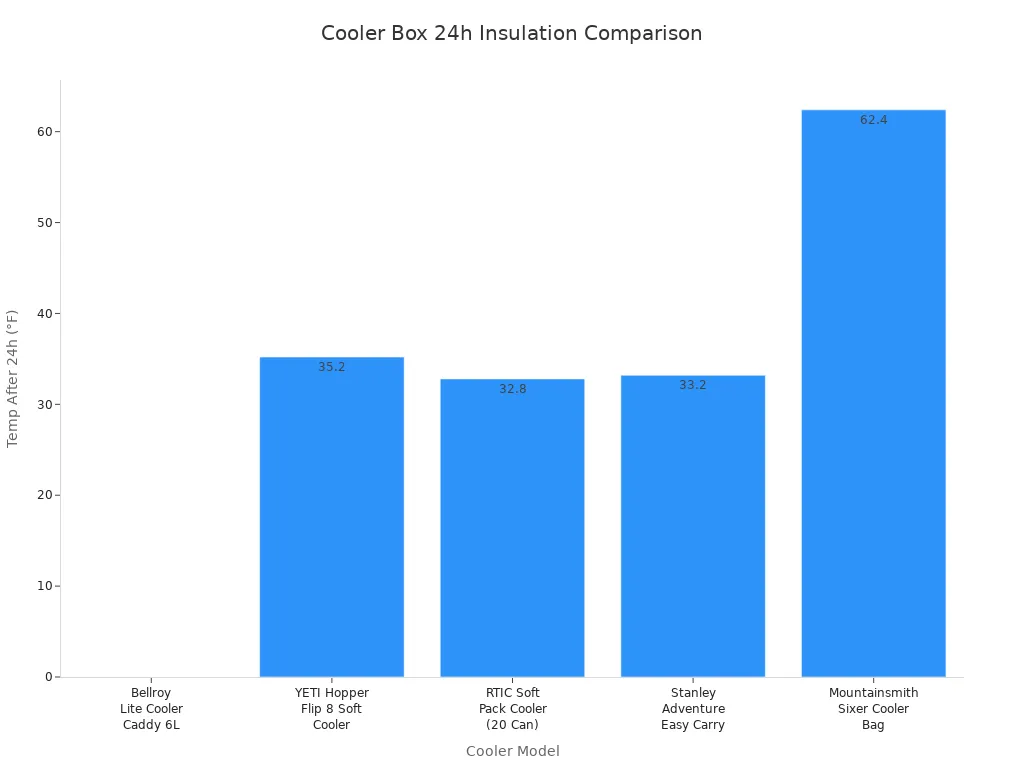
Choose a cooler that matches your travel style. Soft coolers fit in backpacks, while hard coolers protect your food in the trunk.
Specialized Uses
Some activities need special features. Medical transport coolers keep vaccines, blood, or stem cells safe with jostle-free designs and ice packs that hold a steady temperature for hours. These coolers can keep items at 2-8°C, even if it gets hot outside. For fishing or camping, small coolers with rugged insulation and lightweight bodies work best. They keep your catch or lunch cold, even in the sun. Cord blood transport coolers use high-performance insulation and PCM ice bags to keep samples safe for up to 28 hours, even when it’s 37°C outside.
If you need a cooler for medical or scientific use, look for models with strict temperature control and secure compartments. For outdoor fun, pick a cooler that is tough, light, and easy to carry.
Budget and Value
Price Range
When you shop for a small ice cooler box, you’ll see a wide range of prices. Some coolers cost as little as $60, while premium models can go up to $250 or more. The price usually depends on the size, build quality, and extra features. Here’s a quick look at how some popular models compare:
| Cooler Model | Price | Capacity (quarts) | Construction | Key Features & Notes |
|---|---|---|---|---|
| Igloo Ecocool 52 | $60 | 52 | Injection-molded | Entry-level; decent ice retention (~3 days), lacks drain plug and latches, basic durability |
| Coleman Classic 70 | $85 | 70 | Plastic | Budget; larger capacity, limited ice retention (~2-3 days), affordable, basic build quality |
| RTIC 52 QT Ultra-Light | ~$199 | 52 | Not specified | Mid-range; balances price, weight, and performance |
| Yeti Roadie 24 | $250 | 24 | Rotomolded | Premium; best-in-class ice retention, durable, advanced features, compact and easy to carry |
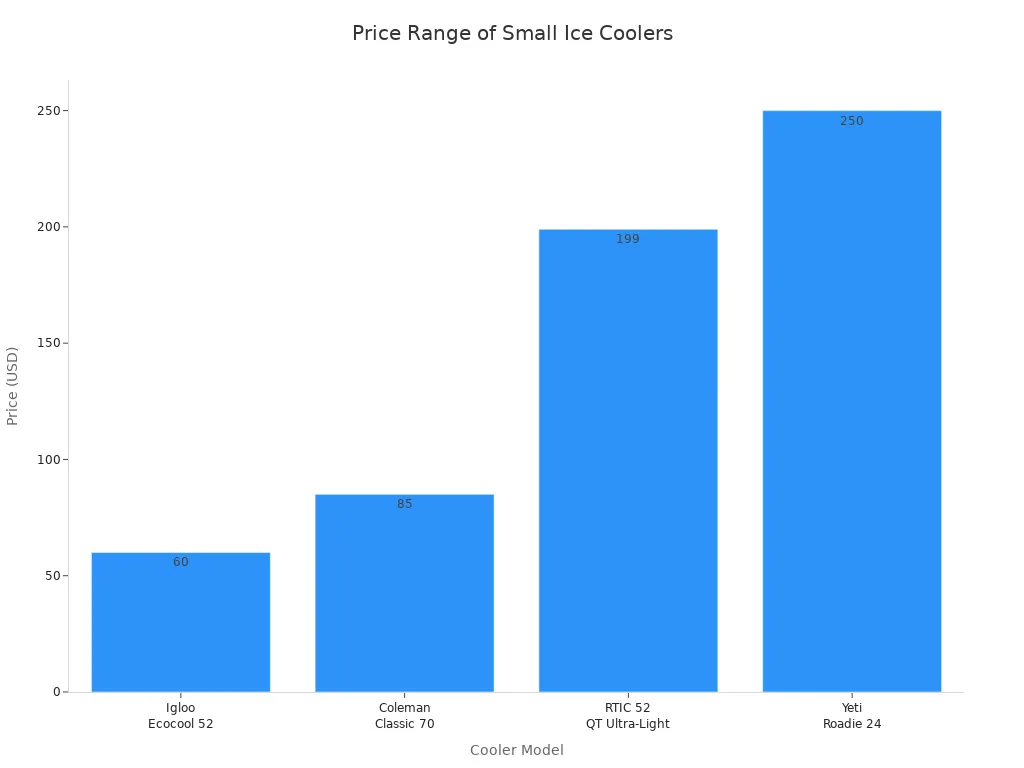
You can see that as the price goes up, you often get better materials and more features. Entry-level coolers work well for short trips, while premium coolers offer top performance and durability.
Value for Money
Setting a budget helps you find the right cooler without overspending. You want to get the most for your money, so think about how often you’ll use your cooler and what features matter most to you.
- Premium soft coolers like Yeti’s Hopper M30 and Engel’s HD30 have tough exteriors and last longer. They cost more, but you get better durability.
- Budget soft coolers, such as the Coleman Chiller, are great for casual use. They don’t last as long or keep ice as well, but they save you money.
- Spending more on a hard-sided cooler often gives you better cooling and a stronger build. Experts say this is a smart choice if you need your cooler to last.
- Some premium coolers, like the Engel Cooler Dry Box, stand out for their build quality and waterproof design. They can even be submerged in water up to 3 feet. However, their ice retention may not be much better than cheaper models, especially in small sizes.
Tip: If you use your cooler often or need it for tough trips, paying more for durability makes sense. For quick outings, a budget cooler might be all you need.
KUER’s Options
KUER offers small ice cooler boxes that focus on both value and quality. The 2023 KUER Insulated 75L Plastic Fish and Food Cooler Box uses food-grade LLDPE material and has UV resistance. You get ice retention for 5-7 days, which is great for longer trips. The cooler is waterproof and leakproof, so you don’t have to worry about spills. KUER also lets you customize your cooler with your own logo or design.
You’ll find features like:
- Heavy-duty ergonomic handles for easy carrying
- Split lid design for quick access
- Internal compartments to keep things organized
- Several size options for different needs
KUER stands behind its products with a warranty and helpful after-sales support. If you want a cooler that lasts and fits your style, KUER gives you plenty of choices. You can pick a model that matches your budget and your adventures.
When you pick an ice cooler box small, focus on insulation, durability, and the right size for your needs. Experts say you should check how long a small cooler keeps things cold, how easy it is to carry, and if it fits your storage space. Think about your daily routine and choose small coolers that match your activities. If you want help or want to see more options, reach out to KUER’s team by email, phone, or their contact page.
FAQ
How long can a small ice cooler box keep ice?
Most small coolers keep ice for 1 to 3 days. Premium models with thick polyurethane insulation can hold ice for up to 5 days. Packing your cooler full and keeping it out of direct sun helps ice last longer.
What size cooler do I need for a day trip?
For a day trip, a 20- to 30-quart cooler works well. You can fit about 16 to 24 cans with ice. This size is easy to carry and fits in most car trunks.
Can I use a small cooler for both food and drinks?
Yes, you can. Use separate containers or bags inside your cooler to keep food and drinks organized. This helps prevent leaks and keeps everything cold longer.
How do I clean my small ice cooler box?
Wipe the inside with warm, soapy water. Rinse and dry it completely before storing. For tough stains, use a mix of baking soda and water. Avoid harsh chemicals to keep your cooler safe for food.

